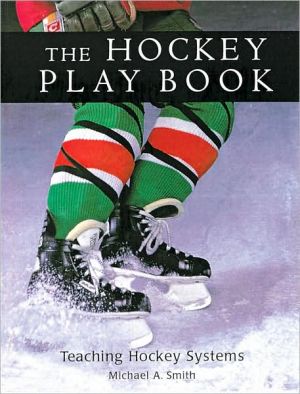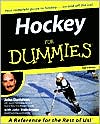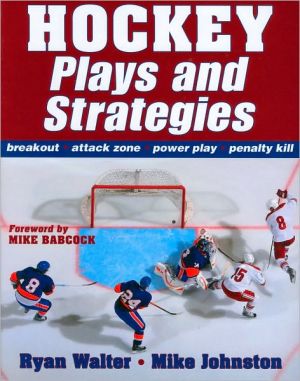Hockey Play Book: Teaching Systems to Amateur Players
The bible for hockey coaches at all levels of competition.\ The Hockey Play Book is a practical handbook for coaches seeking better players and better team-play.\ The book features systems for defensive, offensive and special-team situations, all accompanied by annotated, easy-to-understand diagrams. The systems range from conservative to aggressive -- some are intended for big, physical teams; others for fast-skating and highly skilled teams; and some work for both. Also included are...
Search in google:
A practical handbook for hockey coaches features systems for defensive, offensive and special-team situations, as well as skill building drills. Includes 500 step-by-step diagrams, teaching strategies, conservative and aggressive systems.
General Introduction \ Hockey is a game played by young athletes and a game in which youth is not entirely determined by age. NHL players bring the same enthusiasm to the rink as eight-year-olds, and no matter what level the players, it is the coach's responsibility to create an atmosphere and environment that gives shape to that enthusiasm. Games are fun. That is why people of all ages play them.\ The techniques explained in these pages are cut-and-dried; the diagrams and text are brief and to the point. Coaches reading this book, however, need to remember that their job is to bring these plays to life and that the lessons contained in this book are intended to channel players' excitement, never to stifle it.\ This book focuses on the different systems that are part of hockey. There is no one system, no best system, no secret system. Hockey systems are not complex or difficult to learn, although some, it is true, can be challenging to execute. They do take teamwork, though, and it is part of the coach's job-actually, a major part-to foster an eager and effective team spirit and, once it exists, to orchestrate its actions.\ When I started coaching in the early '70s, I thought the road to being a good coach was straight. If I learned A and then B and C, and so on, I would become a skilled coach and know everything I needed to know. But I discovered that the more I learned, the less I knew for sure. What once looked clear and simple often became gray and diffused.\ I concluded that a good coach had to become an artist and that the process of guiding a hockey team was subjective. I learned that a good coach must constantly create if he is to enable his playersand his team to grow.\ The purpose of this book, then, is to provide resources for coaches who are caught up in their own creative efforts. These chapters include different systems for hockey's defensive, offensive and special team situations. Teaching methods and drills are provided, and the systems run the gamut from the conservative to the aggressive. Some systems are designed specifically for big physical teams or for fast-skating and highly skilled teams or for teams that have both. In this book, there should be a system for every coach.\ But here is a warning. Despite the look of this book, hockey is definitely not a game of x's and o's. Diagrams help, but a coach is in trouble if ever he thinks players can learn the game from a chalkboard. It is vital not to make hockey rigid. It is a fast-flowing game with the opportunity for physical confrontation, and it is important for the coach to incorporate both the flow and the physical elements into his plans.\ In a sense, the game of hockey resembles jazz. Talents and skills are necessary, but a basic framework is required within which to exercise these abilities. Both jazz and hockey demand improvisation; the individual player doing the extra unexpected bit makes the system work. The individuals play off each other and constantly adjust to one another, and in hockey, just as in jazz, too much planning can ruin everything.\ There is no perfect system. Different coaching philosophies emphasize different techniques. Coaches who believe in aggressive, attacking play proceed differently than coaches who believe in a conservative, close-checking approach. Some coaches want aggression in some zones and conservative play in others, and a coach must come to grips with his philosophy of the game before selecting specific systems for play in any one of them.\ Once a coach has decided what kind of team he has at his disposal and knows roughly how he wants to proceed, this book can help him lay out his plans. It can help with adjustments to his present techniques, and maybe contains a couple of ideas he hasn't thought of before. Later in the season, when the team is in a slump and enthusiasm is slipping away, perhaps this book can even supply a little of the creative magic that every coach should always be looking for.
General IntroductionSection One: Defensive PlayIntroductionChapter One: ForecheckingIntroductionStandard Triangle1-2-21-43-2 Check1-1-3 Off-Wing Stay Back2-3 One Wing Always BackWings Chase and Center Forechecks2-1-2Aggressive 2-1-2One Wing Always DeepAggressive Overload3-2 Press1-2-2 Everything to the Net3-1-1 PressDrillsChapter Two: Neutral Zone DefenseIntroduction1-2-21-1-32-1-2DrillsChapter Three: Defensive Zone PlayIntroductionZone DefenseCombination Zone and Man-to-ManBox Plus OneDrillsSection Two: Offensive PlayIntroductionChapter Four: BreakoutsIntroductionPositional PlayPlaysBoard PlayPlaysFree-Flowing SystemPlaysDrillsChapter Five: Neutral Zone OffenseIntroductionPositional PlayDrillsForwards CrisscrossDrillsRegroup Free MovementDrillsNeutral Zone AttackPlaysChapter Six: Offensive Zone PlayIntroductionPositional PlayDrillsTriangular OffenseDrillsOverload the SlotDrillsSection Three: Special Team PlayIntroduction Chapter Seven: Power PlaysIntroductionThe FunnelDrills2-1-2DrillsDefensemen SlideDrillsWings Play theOff-Side1-2-2PlaysMan in Front of the NetFrom the CornerCzech Power PlayPlaysDiamond FormationChapter Eight: Penalty KillingIntroduction0-41-32-2DrillsTight BoxWide BoxMovable BoxDrillsChapter Nine: Face-OffsIntroductionOffensive Face-OffsDefensive Face-OffsNeutral Zone Face-OffsDrills








